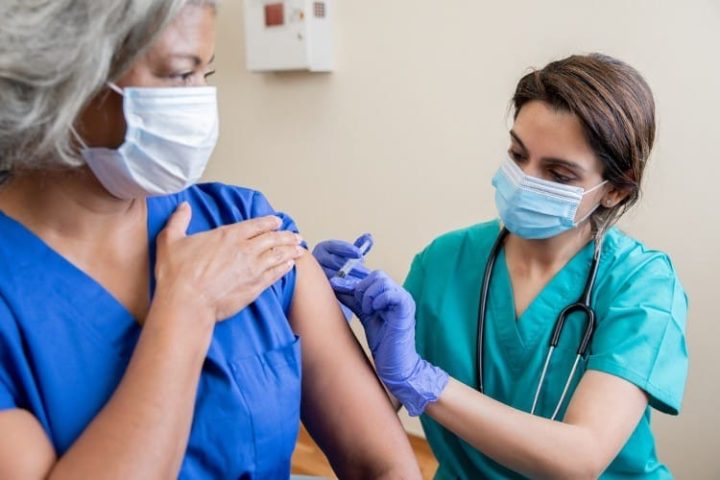
Everything seems so utterly mixed up about the COVID-19 pandemic, that it comes as no surprise that many people are still confused, scared, and readily accept whatever remedy the smart-looking “medical experts” in white robes may offer. Now, some Americans who got Johnson & Johnson’s (J&J) one-dose COVID-19 vaccine are seeking out booster shots of other vaccines to “better protect” themselves against what is believed to be a “highly transmissible” “Delta” variant.
The rationale behind the polishing of adenovirus-based J&J shot with an mRNA-based shot is that the J&J shot alone may be “far less” effective against the SARS-CoV-2 mutations. A recently released study by a team of New York University researchers found the effectiveness of a one-shot J&J is a meager 33 percent, while the Pfizer-BioNTech and Moderna jabs have been touted as having an efficiency of more than 90 percent. In the conclusion, the study’s authors suggested J&J recipients might require booster shots for better protection against the “Delta” variant.
According to J&J, however, there is no need to do so, since their vaccine’s potency against the variation is just slightly lower than it was against the original strain. They claim their jab is effective against the “Delta” eight months after vaccination, and the strength of produced antibodies increases with time.
The trend of mixing vaccines has originated in Europe and is more likely to be explained by supply shortages of COVID-19 vaccines and unforeseen side effects of their widely used AstraZeneca jab. Just like J&J, the AstraZeneca vaccine utilizes adenovirus material to produce an immune response, and is shown to cause severe blood issues such as blood clotting or thrombocytopenia (low number of blood platelets) in some recipients. As a result, many European countries, such as Denmark, Norway, Iceland, and Bulgaria, have suspended its rollout. Moreover, some governments, including those in Great Britain and Germany, recommended their youth to abstain from the jab unless they are high-risk for COVID.
Science magazine reports that the “mix-and-match” approach was born of necessity, but there are early studies that suggest it may be beneficial. The preliminary studies are said to find that following one dose of the vaccine made by AstraZeneca with a dose of the Pfizer-BioNTech vaccine produces strong immune responses, as measured by blood tests. Two of the studies even suggest the mixed vaccine response will be at least as protective as two doses of the Pfizer-BioNTech product, allegedly one of the most effective COVID-19 vaccines.
Scientific American magazine adds that while no mix-and-match trials have yet reported severe side effects, it does not mean there will be none. “You’re combining two different vaccines, both of which might have their own profile of adverse events and effects, which could amplify any problems,” observed Leif Erik Sander at Charité University Hospital in Berlin, even though he believes that mixing adenoviral and mRNA jabs may provide “the best of two worlds” for the recipients. But what if the results turn into “the worst of two worlds?” The answer is pending.
In addition to that, the studies so far have enrolled only a few hundred people, likely too small to pick up “rare” side effects. “You do not pick up your one-in-1,000 side effect, let alone your one-in-50,000 side effect,” admitted Matthew Snape, an Oxford vaccine researcher who led one of the mix-and-match studies.
While the data remain preliminary and very limited, some countries are moving ahead with the controversial approach.
Germany has recently made an official recommendation to mix-and-match, encouraging citizens to follow their AstraZeneca shots with a dose of an mRNA vaccine. Chancellor Angela Merkel led the way by following her initial AstraZeneca dose with a shot of Moderna in June.
Other countries such as Canada and Thailand have started administering vaccines on a heterologous schedule. Numerous other countries are doing the same.
The European Medicines Agency (EMA) and the European Centre for Disease Prevention and Control (ECDC), while not issuing any specific recommendations, promoted the mix-and-match approach in a recent press release, saying the approach “may allow populations to be protected more quickly and make better use of available vaccine supplies.”
Combining whatever vaccines are available in second- and third-world countries that heavily rely on foreign aid through COVAX and similar programs, may be the way to inoculate their population. For example, when Denmark donates AstraZeneca vaccines it considers unsafe to use for its population, and the United States donates its J&J vaccine, and both are considered “good enough” to use, and studies — no matter how limited — “prove” the “cocktail” may be even more effective than the original jabs, local governments in recipient countries are likely to readily accept it. “As the world races to vaccinate as many people as possible against COVID-19, these combination studies could be one more weapon against the just really embarrassing inequality in global vaccine access,” says Hugo van der Kuy, a clinical pharmacologist at Erasmus Medical Center.
Meanwhile, the U.S. Centers for Disease Control and Prevention (CDC) warns against combining the shot. Its website states that “COVID-19 vaccines are not interchangeable” and that “The safety and efficacy of a mixed-product series have not been evaluated. Both doses of the series should be completed with the same product.”
The CDC also noted that getting an adenoviral vector vaccine after the first dose of an mRNA shot could be considered only “in limited, exceptional situations.” Additionally, because the United States still has ample vaccine supply, the rush to start offering the mix-and-match approach isn’t as much of a necessity as it is in countries that continue to struggle for access.
The long-term safety and efficacy of all of the existing COVID-jabs is still pending, as all their recipients may be considered volunteers in a Stage III medical trial. In the light of all of the unknowns and the staggering number of adverse reactions and deaths, many say that mixing such therapeutics seems, to put it mildly, like a very risky idea.




